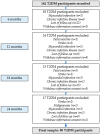The Trend of Changes in Adiponectin, Resistin, and Adiponectin-Resistin Index Values in Type 2 Diabetic Patients with the Development of Metabolic Syndrome
- PMID: 39596980
- PMCID: PMC11596469
- DOI: 10.3390/medicina60111795
The Trend of Changes in Adiponectin, Resistin, and Adiponectin-Resistin Index Values in Type 2 Diabetic Patients with the Development of Metabolic Syndrome
Abstract
Background and Objectives: This study aimed to investigate the novel adiponectin-resistin (AR) index as a predictor of the development of metabolic syndrome (MetS) in individuals with type 2 diabetes mellitus (T2DM). MetS is common in T2DM and increases cardiovascular risk. Adiponectin and resistin, adipokines with opposing effects on insulin sensitivity and inflammation, make the AR index a potential marker for metabolic risk. Materials and Methods: This prospective observational study included 80 T2DM participants (ages 30-60) from Sarajevo, Bosnia and Herzegovina, over 24 months. The participants were divided into two groups: T2DM with MetS (n = 48) and T2DM without MetS (n = 32). Anthropometric data, biochemical analyses, and serum levels of adiponectin and resistin were measured at baseline and every six months. The AR index was calculated using the formula AR = 1 + log10(R) - 1 + log10(A), where R and A represent resistin and adiponectin concentrations. Logistic regression identified predictors of MetS. Results: T2DM patients who developed MetS showed a significant decline in adiponectin levels (40.19 to 32.49 ng/mL, p = 0.02) and a rise in resistin levels (284.50 to 315.21 pg/mL, p = 0.001). The AR index increased from 2.85 to 2.98 (p = 0.001). The AR index and resistin were independent predictors of MetS after 18 months, with the AR index showing a stronger predictive value (p = 0.007; EXP(B) = 1.265). Conclusions: The AR index is a practical marker for predicting MetS development in T2DM participants, improving metabolic risk stratification. Incorporating it into clinical assessments may enhance early detection and treatment strategies.
Keywords: AR index; adiponectin; metabolic syndrome; resistin; type 2 diabetes mellitus.
Conflict of interest statement
The authors declare no conflicts of interest.
Figures




References
Publication types
MeSH terms
Substances
LinkOut - more resources
Full Text Sources
Medical
Research Materials

